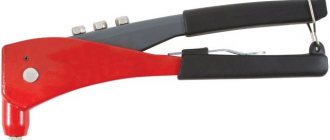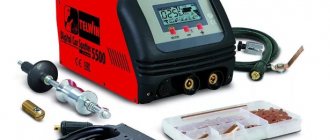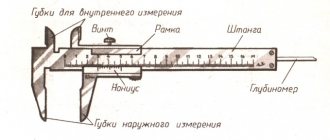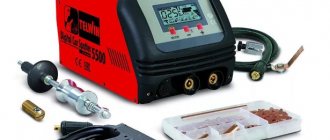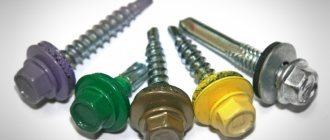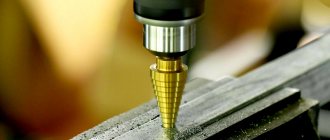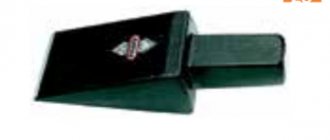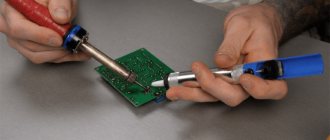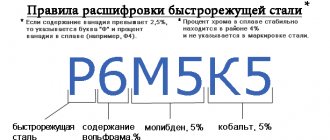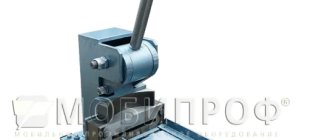DIY dividing heads
The functionality of a milling machine can be significantly increased by using special equipment called a dividing head. It is used in the production of complex parts, as it allows the workpiece to be rotated by a certain degree, which is set by the machine operator. When purchasing a lathe or milling machine, you can count on the equipment being included. In some cases, you can do it yourself.
Angle heads with quick release mandrels
Different angles of inclination of the working tool to the axis of the machine spindle - 30°, 45°, 60°, 90°. Possibility of rotating the mandrel 360°. There is a convenient scale to control the angle of rotation. Standard cones BT-40, BT-50. Available with cone IT-40, IT-50. The stopper can be supplied as a set. Maximum rotation speed - 2000 rpm. For angle heads, NIKKEN produces the following quick-change arbors (pictured from left to right): drilling arbor, threading arbor, disc milling arbor, face milling arbor (compound cutter with a diameter of 50, 60 or 80 mm), collet milling arbor. As well as mandrels for replaceable compound cutters, an adapter for a Morse taper and an adapter for a drill chuck.
Purpose of the equipment
In order to obtain a complex shape, it is often necessary to shift the workpiece relative to the machine axis by a certain angle. It is the dividing head that can be used to solve the assigned problems. It is worth noting that it can become a separate part of a milling or lathe, or its component.
The fastening takes place on the bed of a lathe or other machine. Attachment to the frame can take place in several ways, depending on the type of attachment. The position of the movable element of the equipment for a lathe is set using several handles and a disk. The discs have specific holes that allow you to maintain the position of the tool used to set the angle.
The considered equipment for turning equipment is used to solve the following problems:
- A milling machine is used to produce grooves on the surface of the part. To control the depth and width, parameters are set that are maintained when processing a large batch.
- Edges are formed on the parts. When creating custom-sized nuts, shanks and various tools, you need to use a dividing head, which allows you to set dimensions, angles and other parameters with high accuracy.
- Splines and grooves are also quite often surface milled. Often this is done by shifting the workpiece by a certain angle. It should be noted that the dividing head makes it possible to achieve highly accurate dimensions.
The above points determine that the equipment in question is often simply irreplaceable. You can make it yourself for milling and turning equipment.
Dividing heads: types, purpose, characteristics, calculation table
Increasing the functionality of production equipment is possible after installing a dividing head. It is necessary for the production of complex parts and workpieces. This component is often included by default. If it is missing, it is necessary to correctly select the optimal model.
Purpose of the dividing head
To form a part of the desired shape, it may need to be offset relative to the axis of the machine. This can be done using a dividing head. It can be either a separate part of the structure or its component.
The component is mounted on the equipment frame. It has various options for fixing the product, which depend on the type of attachment. The position is adjusted using several handles and a dial. The latter has holes that fix the position of the dividing component.
A similar tool may be needed to perform the following processes:
- milling grooves on the surface. This does not require great precision. It is important to control the depth and width of the workpiece;
- formation of edges on parts. This is true for non-standard nuts, tools, and shanks. The operation requires high precision;
- milling splines and grooves. This often requires significant displacements of the workpiece. Therefore, you should choose a dividing disk model with a minimum error rate.
To increase the speed of work, the part should not be constantly dismantled. Changing its position relative to the machine cutter occurs using the tool described above. Particularly difficult is the formation of helical grooves. This operation can only be performed using an accurate model.
Before purchasing a dividing head for a specific type of equipment, you must check its compatibility with the machine. Any independent alteration of the installation part may affect the quality of the product.
Types of dividing head
Multi-function dividing head
Considering the specifics of the application, you should familiarize yourself in detail with the types and general classification of dividing heads. They are mandatory for universal milling machines. The configuration of horizontal milling machines is carried out only when it is necessary to perform complex work.
First of all, you need to decide on the types of work performed on the machine. Particular attention is paid to the accuracy of their implementation.
Can I do it myself?
The cost of the industrial design device in question is quite high, which is associated with the use of expensive materials and modern equipment in production. You can make a dividing head with your own hands, for which several points should be taken into account. To perform simple work, many people decide to make a turning mechanism with their own hands.
To create the element in question, the following components are needed:
- First you need a worm gearbox. Often it is taken from old technical equipment, and it can also be turned out independently. The worm gearbox is an important design element. Therefore, you need to pay attention to the quality of the design. The presence of even the slightest defects is unacceptable;
- You will also need a lathe chuck and a dial. The optimal diameter of the lathe chuck is 65 millimeters. They can be taken from a drawing board;
- In order to limit the processing progress, a locking screw is installed.
The design itself has many features that should be taken into account when making it yourself.
Classification
There is a certain classification of the system for shifting the workpiece at a certain angle:
- Simple - This design option is quite simple to create, easy to set up and use. The main elements can be called the spindle on which the workpiece is attached, and the second is the dial, which has several holes on the surface. The design is simple and reliable, but cannot be used to obtain ultra-precise parts.
- Combined - control is performed using a handle. The number of presses affects how much the workpiece deviates from the central axis. The combined version is used in the production of complex devices.
- Universal - this device is a complex technological complex, which is controlled by a handle and a dividing disk. The design has several gear systems. In some cases, this DG is called differential.
The above points should be taken into account when considering which device can be used for processing workpieces.
Types of dividing head
Multi-function dividing head
Considering the specifics of the application, you should familiarize yourself in detail with the types and general classification of dividing heads. They are mandatory for universal milling machines. The configuration of horizontal milling machines is carried out only when it is necessary to perform complex work.
First of all, you need to decide on the types of work performed on the machine. Particular attention is paid to the accuracy of their implementation. The next parameter is the complexity and accuracy of setting up the equipment for operation. Depending on these factors, you can select models with high accuracy and acceptable error rates. In some cases, such a device is made independently.
There is the following classification of milling dividing heads:
- simple. A special feature is its simple setup and ease of control. The main component is the spindle, on which the workpiece is attached on one side, and the second is connected to a special disk (limbo). The surface of the latter has holes (from 2 to 24). With their help, the part is shifted relative to the milling axis;
- combined. Control occurs using a handle. The greater the number of clicks, the greater the distance between the central axis of the workpiece and the cutting tool. Used for the manufacture of complex parts;
- universal. They are a complex technological complex, the adjustment of which is carried out both using the switching number of the handle and during the movement of the disk itself. This is done by a system of gears. This type of DG is called differential.
It is also recommended that you familiarize yourself with the accepted labeling. It will help you determine the optimal model and find out its parameters. As an example, we can consider the decoding of the name UDG-40-D250:
- UDG. This device designation is Universal Dividing Head;
- 40 – gear ratio value. It shows how many turns of the handle the spindle will rotate 360°;
- D250 is the maximum permissible size of the workpiece being processed.
UDG class models are most often used to form complex edges and surfaces. They are made to order or are components of universal milling machines.
Rarely encountered optical types are marked ODG-5, where 5 is the price of one division in seconds.
Specifications
A homemade dividing head must have certain technical characteristics, among which we note:
- maximum diameter or overall dimensions of the workpiece. This parameter is quite important. It should be taken into account when creating a homemade dividing head. the maximum diameter is indicated for turning equipment, for milling equipment the width, length and height are indicated, that is, linear dimensions;
- worm pair ratio;
- replacement wheel diameter;
- output spindle diameter;
- diameter of the cartridge used;
- the price of one division of the dial. A dial is necessary to rotate the workpiece by a certain degree. The division value indicates the accuracy of the equipment;
- maximum width of keys. Milling equipment is often used to create dowels on a surface. A homemade dividing head is needed to form several keys;
- weight of the structure. This parameter determines the difficulty of using the structure.
Dividing head device
It is worth considering that a homemade dividing head can have varying degrees of accuracy.
Advantages
Using a dividing head, when working on metal on a milling machine, the following additional functionality can be distinguished:
- significantly expand the range of work operations;
- process a workpiece that is located in a convenient or desired position relative to the table plane, both vertically and horizontally;
- simplify metal work with workpieces of various sizes.
to menu
Classification
Universal dividing heads have their own designation, by which their main operating parameters can be determined:
- UDG 100 - processed workpieces with a diameter of 100 mm, dimensions at the base - 260x180 mm, weight - 25 kg;
- UDG 125 - it can be used to process workpieces whose maximum diameter does not exceed 125 mm. Base dimensions - 260x180 mm. Weight - 28 kg;
- UDG 250 - the maximum permissible diameter of the workpiece being processed is 250 mm, dimensions - 260x180 mm, weight - 53.6 kg;
- UDG 320 - the workpiece should not exceed 320 mm in diameter, base dimensions - 290x234 mm, weight - 101 kg;
- UDG 400 is the largest dividing head, which allows you to work with workpieces with a cross-section of up to 400 mm. Overall dimensions of the base - 290x234 mm, weight - 106 kg.
All of the above devices have a division value on the dial of 15º.
Universal dividing head UDG-250
Many parameters are the same, since the use of these devices is designed for standard equipment. The difference is mainly in the diameter of the parts being processed - the larger it is, the larger and heavier the device.
Another type of notation is used. For example - UDG 40 D250. This means that the dividing head is universal; for a full revolution of the spindle, you need to turn the handle 40 times, the maximum diameter of the workpiece should not exceed 250 mm. to menu
Optical dividing head
Such a device is used to perform particularly precise divisions, and in some cases, to check the correctness of the division performed on another device.
At the top of the head there is a microscope eyepiece, in the optical system of which a fixed scale is placed. The division price in it is 1′, and the total number of parts is 60. The divisions are visible so clearly that counting a fraction of ¼ minutes is not difficult at all.
The spindle rotation angle is calculated in the same way as for a mechanical head. But it should be noted that it is necessary to make a table of all successive angles, since they are summed up. to menu
Homemade dividing head
For small amounts of metal work done by hand, it makes no sense to buy expensive additional equipment, since the investment will never pay off.
Homemade dividing head
But home craftsmen who have a milling machine at their disposal still need such a device as a dividing head. To create it, you will need a worm gear, a lathe chuck with a diameter of about 65 mm, and a disk (limb).
The layout of these elements is standard; nothing new needs to be invented. The divisions (holes) on the disk are made to suit your individual needs. Everything else is similar to the industrial options.
After assembling the homemade structure, it is necessary to adjust it. This is done after the part made on a milling machine using a homemade dividing head is compared in terms of parameters with the factory sample. to menu
Additional Information
The use of different types of milling heads allows you to process parts on one machine, while without their use, it is necessary to use several. There is additional equipment for milling machines in the form of the following types of heads:
- corner;
- boring;
- slotting.
In turn, they can be manufactured in several versions, for example, with replaceable knives or plates.
Semi-universal dividing head HOMGE BS-0
The angular head also has several design options:
- 90º head:
- modular type;
- universal.
All these additional devices (angular, boring, slotting heads) significantly increase the accuracy and increase the productivity of milling equipment, as they allow vertical and horizontal processing, as well as work at an angle, without reinstalling the workpiece.
data-full-width-responsive=”true” data-ad-client=”ca-pub-8514915293567855″data-ad-slot=”8040443333″>
This is interesting: Dividing heads for milling machines - types, instructions
Why do they do it themselves?
When considering a homemade version, the following points should be taken into account:
- The device has a low cost due to the use of used elements.
- All work can be done independently without using the services of a qualified specialist.
- The reliability of the device can depend on many things. When performing work, you should control the quality of assembly at every stage
- You can use a homemade version only when producing a small number of parts, the accuracy of which is less.
- Maintainability can be called an advantage of the device.
Manufacturing of dividing disks
Dividing discs are made according to a round template cut out of thick cardboard. Circles are drawn along the edge of the template, which are divided into a given number of parts. The resulting shares are carefully measured with a dividing tool. The template, sandwiched between large washers made of thick plywood, is rigidly fixed to the grinding wheel mandrel included in the machine tool kit. A wooden block is temporarily attached to the machine stand, the end of which should touch the plane of the circle facing the machine (Fig. 68.1 A). A retainer is made from steel wire with a diameter of 1.5 mm and two holes are drilled in the bar using a drill of the same diameter at the level of circles with 48 and 40 products. The dividing points of the circles are pierced and expanded with an awl to a diameter of 1.5 mm. The latch, having passed through the cardboard, should enter the block and secure the position of the template.
Without fixing the position of the template (or temporarily removing it from the mandrel), grind out the index disk and leave it on the machine spindle. If the dividing disk is made with holes, a drilling jig with a hole at the level of the spindle axis is installed on the slide of the support. The holes of the disk and the conductor must have the same diameter.
Having fixed the template on the first division of the 48-part circle, they begin to drill holes. The conductor is brought to the periphery of the disk, leaving a gap of 3-4 mm. (The gap is necessary for free removal of chips.) A drill of the appropriate diameter fixed in a hand or electric drill is fed through the hole in the jig and the disc is drilled to a depth of about 10 mm (Fig. 68.1 B). Since the index disk contains 24 holes, the template is rotated by two divisions on a 48-part scale and fixed. The dividing disk blank will also rotate and a second hole is drilled according to the previous adjustment of the jig. Repeating the operation, all 24 holes are drilled on the dividing disk.
If the dividing disk has not holes, but marks, its scale is cut with a threaded cutter. The cutter is fixed so that its front edge is vertical and the top is at the level of the spindle axis (Fig. 68.1B). The methods for dividing and fixing the template remain the same. The cutter is brought in until it touches the surface of the dividing disk and moved to the right. Along the transverse feed dial, the cutter is fed forward by 0.1-0.2 mm. Using a longitudinal feed, the cutter is driven along the surface of the disk and cuts through the mark. To obtain a deeper groove, the cutter stroke is repeated, increasing the transverse feed to 0.3 mm. When making a two-scale dividing disk (48 and 40 divisions), the score is cut from the end to the middle. First, cut the right scale, stopping the movement of the caliper with the left stop. Then the cutter is turned over and, feeding it from left to right, the second scale is cut using the right stop (Fig. 68.1 D). By combining stops with thin liners, the marks marking 90 and 45″ are cut to a greater length than the others. On a scale with 40 divisions, every 5th mark can have an elongation.
Calculation table of divisions
| Division parts | Number of revolutions | Counted holes | Total holes |
| 2 | 20 | — | — |
| 3 | 13 | 11 | 33 |
| 4 | 13 | 9 | 39 |
| 5 | 13 | 13 | 39 |
| 6 | 19 | — | — |
| 7 | 8 | — | — |
| 8 | 6 | 22 | 33 |
| 9 | 6 | 20 | 30 |
| 10 | 6 | 26 | 39 |
| 11 | 5 | 35 | 49 |
| 12 | 5 | 15 | 21 |
| 13 | 5 | — | — |
| 14 | 4 | 24 | 54 |
| 15 | 4 | — | — |
| 16 | 3 | 10 | 30 |
| 17 | 3 | 3 | 39 |
| 18 | 2 | 42 | 49 |
| 19 | 2 | 18 | 21 |
| 20 | 2 | 22 | 33 |
| 21 | 2 | 20 | 30 |
| 22 | 2 | 28 | 39 |
Processing large parts on a jigsaw
The jigsaw device is included in the set of accessories for the Universal machine. It is used to produce a variety of flat parts with rectilinear and curved contours. However, standard files are designed for processing thin workpieces. An increase in the thickness of the workpiece necessitates the independent production of narrow-blade saws. Saws are made from clock springs 3-8 mm wide, cutting the teeth with a diamond disk (Fig. 68.2A). Before cutting the teeth, the spring blade is released. The teeth are cut with support on a wooden table, into which a thin pin and two stops are driven. After the first cut, the blade is shifted, a pin is inserted into the first slot and the second is cut, moving the blade to the stops, etc. With the second pass of the disk along the blade, the cut diamonds are ground down along the tooth profile. The finished teeth are separated and, without allowing overheating, the file is hardened. The strength of blades with a width of 6-8 mm allows you to saw bars up to 40 mm thick.
Universal dividing head for lathe and milling machine
Turning and milling equipment is designed to carry out work related to the mechanical removal of metal from a workpiece to give it the required shape and size. To perform some work, additional equipment is required, for example, a universal dividing head installed on milling equipment.
Today it is found quite often, as it allows the processing of complex surfaces. As a rule, the rotary head for a milling machine is manufactured and installed at the time of release of the equipment itself, since it is quite difficult to select the most suitable type of equipment. Let's take a closer look at this device.
Purpose of the equipment
A homemade dividing head for a lathe or milling equipment is installed to offset the part relative to the axis of the installed cutting tool with certain indicators. In this way, it is possible to achieve precise positioning of the tool and the workpiece relative to each other in each position. The device can be used for various types of processing.
In order for work to be carried out with high precision, it is also important to eliminate the possibility of vibration of the device. A variety of fastening methods are used, it all depends on the design features. The position can be adjusted during operation of the machine using a movable disk or handle.
The capabilities of the equipment in question include the following points.
- Surface milling to form splines and grooves. The complex configuration of a future part requires the use of special equipment that allows maintaining a certain distance between splines or grooves, as well as their dimensions.
- Milling the surface of an already created groove. Such work is quite difficult to perform, as it requires maximum precision when monitoring the width and depth of the formed recess.
- It is possible to partially automate the process of creating edges on parts. An example is the process of creating nuts with non-standard parameters. Such work also requires high precision.
For normal processing, such equipment is not required.
How to make a dividing disk with your own hands?
The dividing head is a device for periodically rotating the workpiece for subsequent fixation of its surface in the processing zone at the calculated angle.
The production of gears, giving parts flat, shaped and other configurations with the required accuracy, is carried out by milling blanks that are periodically shifted relative to the processing axis.
Design Features
Created for a milling machine, the mechanism can be used on other types of equipment. The device rotates and fixes the workpiece without removing it from the clamping device until the processing is completed.
It is technically not possible to divide the circumference of a part with ensuring accuracy directly in the working area of the machine without the use of a dividing mechanism. (Only clamping systems of CNC machining centers are competitive).
The device also features:
- The workpiece is rotated to any angle with the minimum permissible error.
- Metalworking capabilities increase by an order of magnitude.
- Long workpieces are fastened using a tailstock.
- The cutting tool is constantly adjusted to size.
- The workpiece is fastened with the smallest deviation error from the base parameter.
Kinds
The operating functions of the devices are:
- securing the workpiece;
- its periodic rotation and fixation.
The purposes of the structural elements of different types of installations are the same and consist of:
- metal case;
- rotating part of the head;
- clamping mechanism and division fixation.
The completeness of the scope of tasks is determined by the design elements and there are three types:
- simplified (or direct division);
- universal dividing head;
- optical head.
Simplified dividing heads
Direct division. They have a design of low complexity and are used in the manufacture of standard parts in large quantities: milling slots, grooves, splines and edges of parts. No experience or skills in operation and maintenance are required.
Universal dividing heads (UDG)
The device (UDG) is intended for the production of parts that require a larger division limit than in simplified mechanisms. Selected according to the size of the milling machine. For example: with a table width of 400 mm, UDG-D320 is used. The index (D320) means that the diameter of the part cannot exceed 320 mm.
UDG models are common in industry:
- D160 and D200 with workpiece diameters up to 160 and 200 mm, respectively.
- D250 – for processing massive parts with a diameter of up to 250 mm.
- D320 – workpiece diameter up to 320 mm. With a set of replacement gears and two guitars for them.
- D400 – Dividing disk with a number of holes from 16 to 31, on the one hand, and from 33 to 54, on the other.
Optical dividing heads
In demand when processing cutting tools with a large number of blades. A glass disc with 360° graduation is mounted on the spindle. Visually, using the eyepiece, the angle of rotation is set with the required accuracy.
By rotating the flywheel on the worm wheel shaft, the spindle is rotated. Coupled with the worm wheel, it rotates at the calculated angle and is fixed with a handle located on the housing panel.
Models equipped with a screen make it easier to apply divisions and markings to the workpiece, as well as check the correctness of previously applied hatches.
Benefits of using UDG
Indispensable for the processing of massive parts by tool, repair and restoration and experimental shops in the conditions of piece production. Application in mass or serial production is costly and, often, technologically not justified.
The device allows:
- milling of surface grooves and edges of any complexity;
- with ensuring accuracy, create edges on workpieces, on nuts with non-standard parameters, on the shanks of cutting tools;
- cut grooves, splines and polyhedrons;
- mill sprockets, as well as hollows between wheel teeth.
Division methods
Angular displacement of workpieces is carried out using the following methods:
- Direct division. It is carried out visually using an optical device without the use of intermediate mechanisms.
- Simple division. It is carried out by a fixed UDG disk. Characterized by a wide range of applications.
- Combined division is also carried out using a dividing head.
- The differential method is applicable to UDGs that have a set of replaceable gears.
- The continuous method is implemented by optical and universal heads that have a kinematic connection between the spindle and the longitudinal feed screw of the machine.
How to use?
With the direct division method:
- The worm pair is disengaged by the control handle.
- The dial stop lock is released.
- The spindle rotates by an angle measured by the vernier dial and is fixed.
With a simple division method:
- The dividing disk is fixed in one position.
- By installing the locking handle into the hole on the dividing disk,
- The device moves to the calculated angle.
Differential division method:
- The spindle is set to a horizontal position.
- The smooth rotation of the gears is checked.
- The disc stopper is disabled.
- Further actions are the same as in the simple division method.
Which one is better to choose?
When choosing, the conditions that dictate the selection criteria are considered:
- Parameters of the head and fastening elements on the frame.
- What kind of work do you need a head for:
- for piece repairs or restoration - you need an UDG;
- for high-precision – optical head;
- for flow operation – a head of a simplified design.
Value for money. Cost recovery. New or used. Selecting the country and brand of the manufacturer.
Approximate cost, used
In October 2022, the price of new heads was announced in the range of 40,000–45,000 rubles. UDG diameter 400 mm – 133,000 rub. Used Soviet-made heads, but not used (usually in warehouse storage) - 35,000 rubles. They can be purchased at a relatively reasonable price. Prices for used ones are one and a half to two times cheaper.
Purpose of the equipment
In order to obtain a complex shape, it is often necessary to shift the workpiece relative to the machine axis by a certain angle. It is the dividing head that can be used to solve the assigned problems. It is worth noting that it can become a separate part of a milling or lathe, or its component.
The fastening takes place on the bed of a lathe or other machine. Attachment to the frame can take place in several ways, depending on the type of attachment. The position of the movable element of the equipment for a lathe is set using several handles and a disk. The discs have specific holes that allow you to maintain the position of the tool used to set the angle.
The considered equipment for turning equipment is used to solve the following problems:
- A milling machine is used to produce grooves on the surface of the part. To control the depth and width, parameters are set that are maintained when processing a large batch.
- Edges are formed on the parts. When creating custom-sized nuts, shanks and various tools, you need to use a dividing head, which allows you to set dimensions, angles and other parameters with high accuracy.
- Splines and grooves are also quite often surface milled. Often this is done by shifting the workpiece by a certain angle. It should be noted that the dividing head makes it possible to achieve highly accurate dimensions.
1 - A simple circular saw from a regular drill
circular saw from drill
In this publication, we will make a simple circular saw with a rip fence from an ordinary drill. Of course, this fake will not replace a full-fledged machine, but for the first time it can be a great help.
Read more here: “ A simple circular saw from a regular drill
«
2 - Very simple mini grinder
mini grinding machine
It is often necessary to process small products and workpieces, and this is where low-power and fragile equipment can be very, very useful. Well, let's assemble a mini grinding machine for small workpieces and products.
Read more here: “ Very simple DIY mini grinding machine - step-by-step instructions
«
3 - Simple guide for a hand-held circular saw
guide for circular
Of course, there are hand-held circular saws with guides included, but they are quite expensive, so let’s figure out a simple guide for a regular hand-held circular saw.
Read more here: “ Simple guide for a hand-held circular saw
«
4 - Making a hand router from a regular drill
milling cutter from a drill
Of course, this cannot be called a full-fledged machine, but in the end, instead of a cheap tool, we will have the capabilities of an expensive one. A milling cutter is simply an irreplaceable tool, but a novice master simply may not have it. The solution is simple, you can make a hand router from a simple drill with your own hands, and use it until you have the opportunity to buy a real one.
Read more here: “ We make a manual router from a regular drill with our own hands
«
5 - Simple sawing machine from a hand-held circular saw
circular sawing machine
With the help of a couple of bars and aluminum squares, you can build a very high-quality machine, or rather, a rigid guide for a circular saw. Such a device will make working with a circular saw much faster and easier.
Read more here: “ A simple sawing machine from a hand-held circular saw
«
6 – Sawing machine from a jigsaw
jigsaw sawing machine
You can use a jigsaw instead of a band saw, or you can make a very good sawing machine. As a result, we will get an improvised plunge-cut saw from a jigsaw.
Read more here: “ Do-it-yourself sawing machine from a jigsaw - step-by-step instructions
«
7 - Simple drilling machine from a screwdriver
drilling machine from a screwdriver
Very often, when making various products, we need to make a hole strictly at an angle of 90 degrees. It is almost impossible to make such a hole “by eye”. For this task, you can easily adapt a screwdriver; just a couple of hours and we will have a very good drilling machine in our hands.
Read more here: “ A simple drilling machine from a screwdriver with your own hands
«
8 - Large drilling machine from a drill
large drilling machine from a drill
Making a hole at an exact 90 degree angle with a conventional drill is not an easy task. A homemade drilling machine will not only make this task easier, but will even expand the functionality of the drill. Let's see how you can assemble a high-quality drilling machine.
Read more here: “ We make a drilling machine from a drill with our own hands
«
9 - Band saw from a jigsaw
jigsaw band saw
If desired, a regular jigsaw can be successfully transformed into a band saw. If you are planning to cut out not very thick figures from plywood or wood, then you will like this machine.
Read more here: “ Do-it-yourself band saw from a jigsaw
«.
10 - Belt sander from a drill
belt sander from drill
Do you often have to sand wood or other materials, and are you tired of doing it by hand? A regular hand drill will make this process very easy!
Read more here: “ Do-it-yourself belt grinder from a drill
«
11 — Lathe from a drill
drill lathe
A lathe is a very useful thing and will help solve many problems. With a little effort, you can get a very good lathe from an ordinary hand drill, which will at least help you last until the time when a real one appears in the workshop.
More details here: “ Do-it-yourself lathe from a drill. Part 1
«, «
Do-it-yourself lathe from a drill. Part 2
«
If you found the article interesting and useful, then be sure, just be sure to like and subscribe!!!
Also, don’t forget about the channel , everything is interesting there too. Send all suggestions, wishes and criticism to or in the comments under the publication!
Homemade dividing head for a lathe
» Machine » Boring head for milling machine
Boring work, the main purpose of which is to give existing holes the required parameters, can be performed using boring, milling and turning machines. Such work (for example, primary processing of a previously created hole or shifting its position relative to the axis) is performed only after the final completion of drilling (or reaming).
Boring work performed on a milling machine requires special tools.
So, they can be either multi-blade (multi-cutting) or milling cutters, which are constantly rotating bodies during operation, covered with both wear-resistant and durable teeth.
Milling cutters are one of the most important tools that allow processing of metal surfaces and are very diverse.
In fact, a boring head is a piece of special equipment, the main purpose of which is to hold the teeth described above (or cutters, depending on the choice of the main work tool) when using them to perform drilling, boring or other operations (milling).
Part design and operating principle
In general, the boring head allows you to place either one or several cutting elements at once, however, it is recommended to resort to the optimal design with two radially spaced teeth, since this:
- Helps balance the radial component of the cutting force, which has a positive effect on accuracy;
- Significantly reduces the flow of vibration coming from the tool;
- In principle, it has a positive effect on the dynamics of the boring process.
At the same time, increasing the teeth will not have a positive effect on the work, since this entails a complication of the entire structure, plus, it makes it impossible for the operator at the machine to work at high speeds (fraught with the appearance of defects).
The boring head is fastened in the machine spindle (on the main executive body of the milling machine, that is, essentially, a rotating shaft that transmits force from the machine engine), while the part body is firmly fixed using a nut (or a group of nuts, or using micrometric screws).
The main components of the design of such equipment are the following parts:
- The hub is the central part of the equipment with a small hole that is necessary for mounting on the torque element. The mounting location for this part is the shank, described below, fastening is carried out through four screws, two of which additionally connect the quill;
- A quill that secures the cutting element;
- A slider, which is a moving part inside the quill along two guides using a lead screw. With its help, you can adjust the position of the cutting component relative to the center of the existing hole;
- Tapered shank that precisely fits the front spindle bore. Through this part, rotation is transmitted to the tool.
The process of working with the boring head is as follows:
- The shank is inserted into the spindle (into the cone-shaped hole), after which it is tightened with a screw to ensure tightness;
- After this, the part must be firmly installed in a vice or some other similar equipment;
- If it is necessary to bore a hole of less than 40 mm, then the position of the cutting component is adjusted only using a slider;
- In the case of boring a hole with a larger diameter (up to 85 mm), you should first repeat what was described in the paragraph above, after which the slider should be moved to its initial position, loosen the fastening screws and move the quill into the hub until it stops.
Device classification
The dividing head for a milling machine, the table of technical parameters determines what kind of work can be carried out on this or that equipment. Considering the classification of the dividing head, we note the following types of device.
- Simple model. Its distinctive features include light weight and ease of control. The main part of the structure is represented by a spindle, which is connected to a disk limb.
- Combined model. This version can be adjusted with a special handle. By increasing the number of clicks, you can increase the distance between the center axis of the workpiece being processed and the installed cutting tool.
- Universal samples represented by complex models. In this case, adjustment is carried out using a disk element and a handle. The complexity of the design is determined by the presence of differential gears.
Repairing almost every design option is complicated, since you need to know the principle of operation and carry out the manufacture of all parts.
Advantages
Using a dividing head, when working on metal on a milling machine, the following additional functionality can be distinguished:
- significantly expand the range of work operations;
- process a workpiece that is located in a convenient or desired position relative to the table plane, both vertically and horizontally;
- simplify metal work with workpieces of various sizes.
to menu
Classification
Universal dividing heads have their own designation, by which their main operating parameters can be determined:
- UDG 100 - processed workpieces with a diameter of 100 mm, dimensions at the base - 260x180 mm, weight - 25 kg;
- UDG 125 - it can be used to process workpieces whose maximum diameter does not exceed 125 mm. Base dimensions - 260x180 mm. Weight - 28 kg;
- UDG 250 - the maximum permissible diameter of the workpiece being processed is 250 mm, dimensions - 260x180 mm, weight - 53.6 kg;
- UDG 320 - the workpiece should not exceed 320 mm in diameter, base dimensions - 290x234 mm, weight - 101 kg;
- UDG 400 is the largest dividing head, which allows you to work with workpieces with a cross-section of up to 400 mm. Overall dimensions of the base - 290x234 mm, weight - 106 kg.
All of the above devices have a division value on the dial of 15º.
Universal dividing head UDG-250
Many parameters are the same, since the use of these devices is designed for standard equipment. The difference is mainly in the diameter of the parts being processed - the larger it is, the larger and heavier the device.
Another type of notation is used. For example - UDG 40 D250. This means that the dividing head is universal; for a full revolution of the spindle, you need to turn the handle 40 times, the maximum diameter of the workpiece should not exceed 250 mm. to menu
Optical dividing head
Such a device is used to perform particularly precise divisions, and in some cases, to check the correctness of the division performed on another device.
At the top of the head there is a microscope eyepiece, in the optical system of which a fixed scale is placed. The division price in it is 1′, and the total number of parts is 60. The divisions are visible so clearly that counting a fraction of ¼ minutes is not difficult at all.
The spindle rotation angle is calculated in the same way as for a mechanical head. But it should be noted that it is necessary to make a table of all successive angles, since they are summed up. to menu
Homemade dividing head
For small amounts of metal work done by hand, it makes no sense to buy expensive additional equipment, since the investment will never pay off.
Homemade dividing head
But home craftsmen who have a milling machine at their disposal still need such a device as a dividing head. To create it, you will need a worm gear, a lathe chuck with a diameter of about 65 mm, and a disk (limb).
The layout of these elements is standard; nothing new needs to be invented. The divisions (holes) on the disk are made to suit your individual needs. Everything else is similar to the industrial options.
After assembling the homemade structure, it is necessary to adjust it. This is done after the part made on a milling machine using a homemade dividing head is compared in terms of parameters with the factory sample. to menu
Additional Information
The use of different types of milling heads allows you to process parts on one machine, while without their use, it is necessary to use several. There is additional equipment for milling machines in the form of the following types of heads:
- corner;
- boring;
- slotting.
In turn, they can be manufactured in several versions, for example, with replaceable knives or plates.
Semi-universal dividing head HOMGE BS-0
The angular head also has several design options:
- 90º head:
- modular type;
- universal.
All these additional devices (angular, boring, slotting heads) significantly increase the accuracy and increase the productivity of milling equipment, as they allow vertical and horizontal processing, as well as work at an angle, without reinstalling the workpiece.
data-full-width-responsive=”true” data-ad-client=”ca-pub-8514915293567855″data-ad-slot=”8040443333″>
DIY making
The cost of such equipment can be quite high. This is why many people wonder how to make a dividing disk with their own hands. A drawing of the future product is created depending on the characteristics of the equipment on which the dividing head will be installed. In addition, you will need the following components.
- Lathe chuck with dial.
- Limit screw.
- A worm gearbox, which can be obtained by dismantling old machines or made with your own hands.
After manufacturing the product, the dividing part is adjusted. To do this, you can use any previously manufactured part. After obtaining certain results, a final calibration is performed, which can significantly improve the processing accuracy.
The immediate process of setting up an element can be described as follows.
- The transformation of 360 degrees of the disk is carried out by the required number of divisions, due to which sectors are allocated.
- The calculated value of the sine of the angle is displayed.
- The disk is set according to the result obtained. It is important to maintain high precision when installing the equipment in question.
- The body is fixed using a special mechanism or handle.
Universal dividing head for lathe and milling machine
Turning and milling equipment is designed to carry out work related to the mechanical removal of metal from a workpiece to give it the required shape and size. To perform some work, additional equipment is required, for example, a universal dividing head installed on milling equipment.
Today it is found quite often, as it allows the processing of complex surfaces. As a rule, the rotary head for a milling machine is manufactured and installed at the time of release of the equipment itself, since it is quite difficult to select the most suitable type of equipment. Let's take a closer look at this device.
Purpose of the equipment
A homemade dividing head for a lathe or milling equipment is installed to offset the part relative to the axis of the installed cutting tool with certain indicators. In this way, it is possible to achieve precise positioning of the tool and the workpiece relative to each other in each position. The device can be used for various types of processing.
In order for work to be carried out with high precision, it is also important to eliminate the possibility of vibration of the device. A variety of fastening methods are used, it all depends on the design features. The position can be adjusted during operation of the machine using a movable disk or handle.
The capabilities of the equipment in question include the following points.
- Surface milling to form splines and grooves. The complex configuration of a future part requires the use of special equipment that allows maintaining a certain distance between splines or grooves, as well as their dimensions.
- Milling the surface of an already created groove. Such work is quite difficult to perform, as it requires maximum precision when monitoring the width and depth of the formed recess.
- It is possible to partially automate the process of creating edges on parts. An example is the process of creating nuts with non-standard parameters. Such work also requires high precision.
For normal processing, such equipment is not required.
Device classification
The dividing head for a milling machine, the table of technical parameters determines what kind of work can be carried out on this or that equipment. Considering the classification of the dividing head, we note the following types of device.
- Simple model. Its distinctive features include light weight and ease of control. The main part of the structure is represented by a spindle, which is connected to a disk limb.
- Combined model. This version can be adjusted with a special handle. By increasing the number of clicks, you can increase the distance between the center axis of the workpiece being processed and the installed cutting tool.
- Universal samples represented by complex models. In this case, adjustment is carried out using a disk element and a handle. The complexity of the design is determined by the presence of differential gears.
Repairing almost every design option is complicated, since you need to know the principle of operation and carry out the manufacture of all parts.
Advantages
Using a dividing head, when working on metal on a milling machine, the following additional functionality can be distinguished:
- significantly expand the range of work operations;
- process a workpiece that is located in a convenient or desired position relative to the table plane, both vertically and horizontally;
- simplify metal work with workpieces of various sizes.
to menu
Classification
Universal dividing heads have their own designation, by which their main operating parameters can be determined:
- UDG 100 - processed workpieces with a diameter of 100 mm, dimensions at the base - 260x180 mm, weight - 25 kg;
- UDG 125 - it can be used to process workpieces whose maximum diameter does not exceed 125 mm. Base dimensions - 260x180 mm. Weight - 28 kg;
- UDG 250 - the maximum permissible diameter of the workpiece being processed is 250 mm, dimensions - 260x180 mm, weight - 53.6 kg;
- UDG 320 - the workpiece should not exceed 320 mm in diameter, base dimensions - 290x234 mm, weight - 101 kg;
- UDG 400 is the largest dividing head, which allows you to work with workpieces with a cross-section of up to 400 mm. Overall dimensions of the base - 290x234 mm, weight - 106 kg.
All of the above devices have a division value on the dial of 15º.
Universal dividing head UDG-250
Many parameters are the same, since the use of these devices is designed for standard equipment. The difference is mainly in the diameter of the parts being processed - the larger it is, the larger and heavier the device.
Another type of notation is used. For example - UDG 40 D250. This means that the dividing head is universal; for a full revolution of the spindle, you need to turn the handle 40 times, the maximum diameter of the workpiece should not exceed 250 mm. to menu
Optical dividing head
Such a device is used to perform particularly precise divisions, and in some cases, to check the correctness of the division performed on another device.
At the top of the head there is a microscope eyepiece, in the optical system of which a fixed scale is placed. The division price in it is 1′, and the total number of parts is 60. The divisions are visible so clearly that counting a fraction of ¼ minutes is not difficult at all.
The spindle rotation angle is calculated in the same way as for a mechanical head. But it should be noted that it is necessary to make a table of all successive angles, since they are summed up. to menu
Homemade dividing head
For small amounts of metal work done by hand, it makes no sense to buy expensive additional equipment, since the investment will never pay off.
Homemade dividing head
But home craftsmen who have a milling machine at their disposal still need such a device as a dividing head. To create it, you will need a worm gear, a lathe chuck with a diameter of about 65 mm, and a disk (limb).
The layout of these elements is standard; nothing new needs to be invented. The divisions (holes) on the disk are made to suit your individual needs. Everything else is similar to the industrial options.
After assembling the homemade structure, it is necessary to adjust it. This is done after the part made on a milling machine using a homemade dividing head is compared in terms of parameters with the factory sample. to menu
Additional Information
The use of different types of milling heads allows you to process parts on one machine, while without their use, it is necessary to use several. There is additional equipment for milling machines in the form of the following types of heads:
- corner;
- boring;
- slotting.
In turn, they can be manufactured in several versions, for example, with replaceable knives or plates.
Semi-universal dividing head HOMGE BS-0
The angular head also has several design options:
- 90º head:
- modular type;
- universal.
All these additional devices (angular, boring, slotting heads) significantly increase the accuracy and increase the productivity of milling equipment, as they allow vertical and horizontal processing, as well as work at an angle, without reinstalling the workpiece.
data-full-width-responsive=”true” data-ad-client=”ca-pub-8514915293567855″data-ad-slot=”8040443333″>
This is interesting: Dividing heads for milling machines - types, instructions
